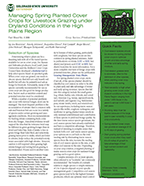Displaying 1 to 15 of 63 Publications
Managing Spring Planted Cover Crops for Livestock Grazing under Dryland Conditions in the High Plains Region
by Sandy Johnson Joe Brummer et al.
MF3443
Recommended practices for species selection, adjusting stocking rates, and grazing. Produced in collaboration with extension specialists and research scientists at Colorado State University and University of Nebraska. Colorado's page for this publication: Managing Spring Planted Cover Crops...
Published Date: Dec 2018
Enhancing Intensive Early Stocking plus Late-Season Grazing for Stocker Cattle in the Kansas Flint Hills
by Walter H. Fick Clenton Owensby
MF3569
The publication describes a three-year grazing rotation of two years of enhanced intensive early stocking plus late-season grazing followed by one year of season-long grazing at the normal grazing rate. This proved to be a sustainable grazing scheme, which greatly increased profitability for stocker grazing in the Kansas Flint Hills region. 4 pages, color.
Published Date: May 2021
Beef Cattle: Practices to Improve Sustainability
by Jaymelynn Farney et al.
MF3269
Producers can reduce the environmental impact of livestock production while increasing profits by using the practices suggested in this fact sheet. 4-page, color.
Published Date: Aug 2019
Red Flag Warning and Fire Weather Information
by Eric Ward
MF2775
Weather is important in conducting a prescribed burn on pastures and range. No burning should be conducted on a Red Flag day. Fire weather information is available online. 2 pages, 2 color.Revision Date: Apr 2022
Nutritional Composition of Feedstuffs for Beef Cattle
MF3648
This publication summarizes the nutrient composition of feed ingredients for dietary formulation and evaluation for beef cattle. Feedstuffs considered commonly available to producers across Kansas are included, along with additional ingredients for which composition values are well documented. 12 pages, color.Published Date: Oct 2023
Managing the Prussic Acid Hazard in Sorghum
by Shelby M. Gruss et al.
MF3607
Publication describes best practices for grazing and feeding livestock to reduce the risk from a toxin. Sorghum and related plants can produce a poison, prussic acid. Prussic acid, also known as hydrogen cyanide (HCN), can cause acute toxicity and death. 4 pages, color.Published Date: Jun 2022
Crabgrass: An Alternative Cattle Forage
by Bruno C. Pedreira et al.
MF3644
Publication describes best practices to produce crabgrass from seed to provide grazing and hay to cattle. 4 pages, color.Published Date: Oct 2023
Cover Crops Grown Post-Wheat for Forage Under Dryland Conditions in the High Plains
by Sandy Johnson et al.
MF3523
Presents information on species selection, variability in forage production and challenges associated with grazing cover crops. Also provides recommendations for grazing management, determining stocking rates, and other considerations. 8 pages, color.Published Date: Jun 2020
Fire and Grasslands
by Carol Baldwin et al.
MF3459
Publication describes the benefits of burning grassland to provide better grazing for livestock and better habitat for wildlife, to control woody plants and weeds, and to reduce the risk of wildfire. 4-page, color.Published Date: Jul 2019
How Much Does Kansas Rangeland Burning Contribute to Ambient PM2.5?
by Zifei Liu
MF3358
The smoke from rangeland burning has resulted in air quality concerns, and smoke exposure constitutes public health concerns. The organic particles in smoke can have negative health impacts. This publication examines the effect of rangeland burning on measures of particulate matter in urban areas affected by this smoke. 4 pages, color.Published Date: Jun 2017
Dual-Purpose Wheat: Management for Forage and Grain Production
by Romulo Pisa Lollato et al.
MF3375
This publication describes some of the management techniques used when producers plan to graze wheat fields and harvest a grain crop. 8-page, full color.Published Date: Apr 2017
Alternative Burning Strategies: Effects on Cattle Performance, Grassland, and the Environment
by Jaymelynn Farney et al.
MF3251
Compares the effects of patch burning with traditional pasture burning (prescribed burning). Explores the viability of this practice for reducing greenhouse gas emissions from cattle grazing systems. 4-page, color.Published Date: Feb 2019
Grazing Management: Toxic Plants
MF3244
Cover crops are gaining popularity as annual forages but may pose risks for grazing livestock. This publication describes animal health problems associated with certain species. 8-page, color.Revision Date: Apr 2018
Summer Grazing Strategies for Stocker Cattle in the Kansas Flint Hills
by Walter H. Fick Clenton Owensby
MF3232
Learn strategies to improve profitability when grazing cattle in the Flint Hills. 8-page, 2-color.Published Date: Feb 2016
Dual Purpose Wheat: Improving Grazing Management Using a Smartphone App
by Romulo Pisa Lollato et al.
MF3304
Grazing wheat offers an additional opportunity for your wheat crop. This publication discusses timing and growth stages critical to successful grazing and how a smartphone app can aid in management decisions. 4-page, color.Published Date: Jul 2016
Displaying 1 to 15 of 63 Publications
 Sign in
Sign in















